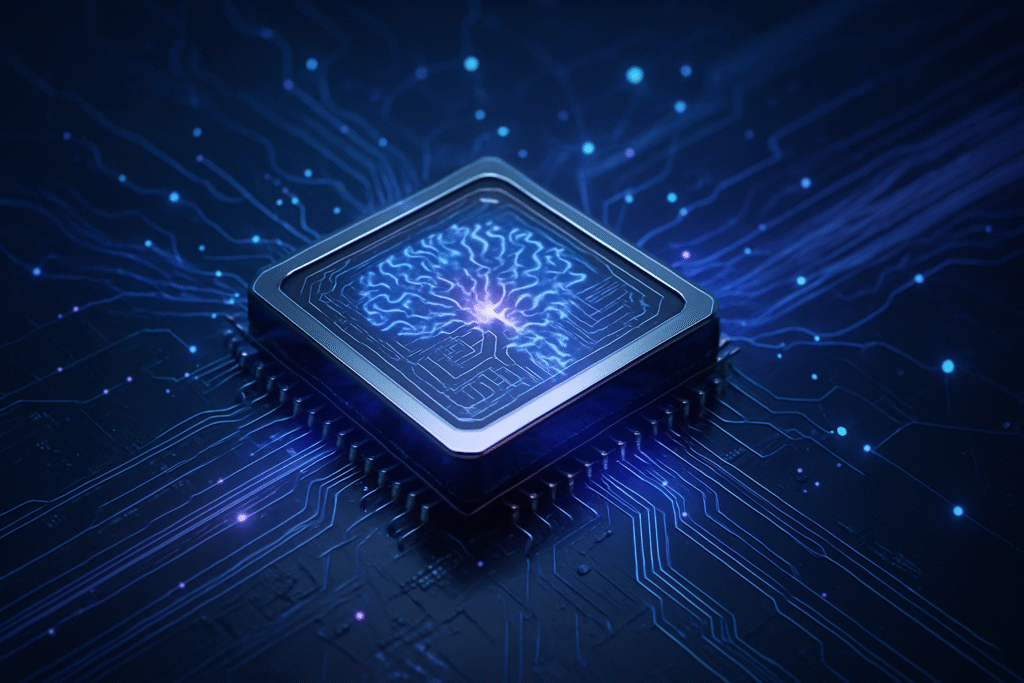
The global semiconductor market is in the throes of an unprecedented "AI Supercycle," a period of explosive growth and transformative innovation driven by the insatiable demand for Artificial Intelligence capabilities. As of October 3, 2025, this synergy between AI and silicon is not merely enhancing existing technologies but fundamentally redefining the industry's landscape, pushing the boundaries of innovation, and creating both immense opportunities and significant challenges for the tech world and beyond. The foundational hardware that underpins every AI advancement, from complex machine learning models to real-time edge applications, is seeing unparalleled investment and strategic importance, with the market projected to reach approximately $800 billion in 2025 and set to surpass $1 trillion by 2030.
This surge is not just a passing trend; it is a structural shift. AI chips alone are projected to generate over $150 billion in sales in 2025, constituting more than 20% of total chip sales. This growth is primarily fueled by generative AI, high-performance computing (HPC), and the proliferation of AI at the edge, impacting everything from data centers to autonomous vehicles and consumer electronics. The semiconductor industry's ability to innovate and scale will be the ultimate determinant of AI's future trajectory, making it the most critical enabling technology of our digital age.
The Silicon Engine of Intelligence: Detailed Market Dynamics
The current semiconductor market is characterized by a relentless drive for specialization, efficiency, and advanced integration, directly addressing the escalating computational demands of AI. This era is witnessing a profound shift from general-purpose processing to highly optimized silicon solutions.
Specialized AI chips, including Graphics Processing Units (GPUs), Application-Specific Integrated Circuits (ASICs), Tensor Processing Units (TPUs), and Neural Processing Units (NPUs), are experiencing skyrocketing demand. These components are meticulously designed for optimal performance in AI workloads such as deep learning, natural language processing, and computer vision. Companies like NVIDIA (NASDAQ: NVDA) continue to dominate the high-end GPU market, while others like Broadcom (NASDAQ: AVGO) and Marvell (NASDAQ: MRVL) are making significant strides in custom AI ASICs, reflecting a broader trend of tech giants developing their own in-house silicon to tailor chips specifically for their AI workloads.
With the traditional scaling limits of Moore's Law becoming more challenging, innovations in advanced packaging are taking center stage. Technologies like 2.5D/3D integration, hybrid bonding, and chiplets are crucial for increasing chip density, reducing latency, and improving power consumption. High-Bandwidth Memory (HBM) is also seeing a substantial surge, with its market revenue expected to hit $21 billion in 2025, a 70% year-over-year increase, as it becomes indispensable for AI accelerators. This push for heterogeneous computing, combining different processor types in a single system, is optimizing performance for diverse AI workloads. Furthermore, AI is not merely a consumer of semiconductors; it is also a powerful tool revolutionizing their design, manufacturing, and supply chain management, enhancing R&D efficiency, optimizing production, and improving yield.
However, this rapid advancement is not without its hurdles. The computational complexity and power consumption of AI algorithms pose significant challenges. AI workloads generate immense heat, necessitating advanced cooling solutions, and large-scale AI models consume vast amounts of electricity. The rising costs of innovation, particularly for advanced process nodes (e.g., 3nm, 2nm), place a steep price tag on R&D and fabrication. Geopolitical tensions, especially between the U.S. and China, continue to reshape the industry through export controls and efforts for regional self-sufficiency, leading to supply chain vulnerabilities. Memory bandwidth remains a critical bottleneck for AI models requiring fast access to large datasets, and a global talent shortage persists, particularly for skilled AI and semiconductor manufacturing experts.
NXP and SOXX Reflecting the AI-Driven Market: Company Performances and Competitive Landscape
The performances of key industry players and indices vividly illustrate the impact of the AI Supercycle on the semiconductor market. NXP Semiconductors (NASDAQ: NXPI) and the iShares Semiconductor ETF (SOXX) serve as compelling barometers of this dynamic environment as of October 3, 2025.
NXP Semiconductors, a dominant force in the automotive and industrial & IoT sectors, reported robust financial results for Q2 2025, with $2.93 billion in revenue, exceeding market forecasts. While experiencing some year-over-year decline, the company's optimistic Q3 2025 guidance, projecting revenue between $3.05 billion and $3.25 billion, signals an "emerging cyclical improvement" in its core end markets. NXP's strategic moves underscore its commitment to the AI-driven future: the acquisition of TTTech Auto in June 2025 enhances its capabilities in safety-critical systems for software-defined vehicles (SDVs), and the acquisition of AI processor company Kinara.ai in February 2025 further bolsters its AI portfolio. The unveiling of its third-generation S32R47 imaging radar processors for autonomous driving also highlights its deep integration into AI-enabled automotive solutions. NXP's stock performance reflects this strategic positioning, showing impressive long-term gains despite some recent choppiness, with analysts maintaining a "Moderate Buy" consensus.
The iShares Semiconductor ETF (SOXX), which tracks the NYSE Semiconductor Index, has demonstrated exceptional performance, with a Year-to-Date total return of 28.97% as of October 1, 2025. The underlying Philadelphia Semiconductor Index (SOX) also reflects significant growth, having risen 31.69% over the past year. This robust performance is a direct consequence of the "insatiable hunger" for computational power driven by AI. The ETF's holdings, comprising major players in high-performance computing and specialized chip development like NVIDIA (NASDAQ: NVDA), Broadcom (NASDAQ: AVGO), and TSMC (NYSE: TSM), directly benefit from the surge in AI-driven demand across data centers, automotive, and other applications.
For AI companies, these trends have profound competitive implications. Companies developing AI models and applications are critically dependent on these hardware advancements to achieve greater computational power, reduce latency, and enable more sophisticated features. The semiconductor industry's ability to produce next-generation processors and components like HBM directly fuels the capabilities of AI, making the semiconductor sector the foundational backbone for the future trajectory of AI development. While NVIDIA currently holds a dominant market share in AI ICs, the rise of custom silicon from tech giants and the emergence of new players focusing on inference-optimized solutions are fostering a more competitive landscape, potentially disrupting existing product ecosystems and creating new strategic advantages for those who can innovate in both hardware and software.
The Broader AI Landscape: Wider Significance and Impacts
The current semiconductor market trends are not just about faster chips; they represent a fundamental reshaping of the broader AI landscape, impacting its trajectory, capabilities, and societal implications. This period, as of October 2025, marks a distinct phase in AI's evolution, characterized by an unprecedented hardware-software co-evolution.
The availability of powerful, specialized chips is directly accelerating the development of advanced AI, including larger and more capable large language models (LLMs) and autonomous agents. This computational infrastructure is enabling breakthroughs in areas that were previously considered intractable. We are also witnessing a significant shift towards inference dominance, where real-time AI applications drive the need for specialized hardware optimized for inference tasks, moving beyond the intensive training phase. This enables AI to be deployed in a myriad of real-world scenarios, from intelligent assistants to predictive maintenance.
However, this rapid advancement comes with significant concerns. The explosive growth of AI applications, particularly in data centers, is leading to surging power consumption. AI servers demand substantially more power than general servers, with data center electricity demand projected to reach 11-12% of the United States' total by 2030. This places immense strain on energy grids and raises environmental concerns, necessitating huge investments in renewable energy and innovative energy-efficient hardware. Furthermore, the AI chip industry faces rising risks from raw material shortages, geopolitical conflicts, and a heavy dependence on a few key manufacturers, primarily in Taiwan and South Korea, creating vulnerabilities in the global supply chain. The astronomical cost of developing and manufacturing advanced AI chips also creates a massive barrier to entry for startups and smaller companies, potentially centralizing AI power in the hands of a few tech giants.
Comparing this era to previous AI milestones reveals a profound evolution. In the early days of AI and machine learning, hardware was less specialized, relying on general-purpose CPUs. The deep learning revolution of the 2010s was ignited by the realization that GPUs, initially for gaming, were highly effective for neural network training, making hardware a key accelerator. The current era, however, is defined by "extreme specialization" with ASICs, NPUs, and TPUs explicitly designed for AI workloads. Moreover, as traditional transistor scaling slows, innovations in advanced packaging are critical for continued performance gains, effectively creating "systems of chips" rather than relying solely on monolithic integration. Crucially, AI is now actively used within the semiconductor design and manufacturing process itself, creating a powerful feedback loop of innovation. This intertwining of AI and semiconductors has elevated the latter to a critical strategic asset, deeply entwined with national security and technological sovereignty, a dimension far more pronounced than in any previous AI milestone.
The Horizon of Innovation: Exploring Future Developments
Looking ahead, the semiconductor market is poised for continued transformative growth, driven by the escalating demands of AI. Near-term (2025-2030) and long-term (beyond 2030) developments promise to unlock unprecedented AI capabilities, though significant challenges remain.
In the near-term, the relentless pursuit of miniaturization will continue with advancements in 3nm and 2nm manufacturing nodes, crucial for enhancing AI's potential across industries. The focus on specialized AI processors will intensify, with custom ASICs and NPUs becoming more prevalent for both data centers and edge devices. Tech giants will continue investing heavily in proprietary chips to optimize for their specific cloud infrastructures and inference workloads, while companies like Broadcom (NASDAQ: AVGO) will remain key players in AI ASIC development. Advanced packaging technologies, such as 2.5D and 3D stacking, will become even more critical, integrating multiple components to boost performance and reduce power consumption. High-Bandwidth Memory (HBM4 and HBM4E) is expected to see widespread adoption to keep pace with AI's computational requirements. The proliferation of Edge AI and on-device AI will continue, with semiconductor manufacturers developing chips optimized for local data processing, reducing latency, conserving bandwidth, and enhancing privacy for real-time applications. The escalating energy requirements of AI will also drive intense efforts to develop low-power technologies and more energy-efficient inference chips, with startups challenging established players through innovative designs.
Beyond 2030, the long-term vision includes the commercialization of neuromorphic computing, a brain-inspired AI paradigm offering ultra-low power consumption and real-time processing for edge AI, cybersecurity, and autonomous systems. While quantum computing is still 10-15 years away from replacing generative AI workloads, it is expected to complement and amplify AI for complex simulation tasks in drug discovery and advanced materials design. Innovations in new materials and architectures, including silicon photonics for light-based data transmission, will continue to drive radical shifts in AI processing. Experts predict the global semiconductor market to surpass $1 trillion by 2030 and potentially $2 trillion by 2040, primarily fueled by the "AI supercycle." AI itself is expected to lead to the total automation of semiconductor design, with AI-driven tools creating chip architectures and enhancing performance without human assistance, generating significant value in manufacturing.
However, several challenges need addressing. AI's power consumption is quickly becoming one of the most daunting challenges, with energy generation potentially becoming the most significant constraint on future AI expansion. The astronomical cost of building advanced fabrication plants and the increasing technological complexity of chip designs pose significant hurdles. Geopolitical risks, talent shortages, and the need for standardization in emerging fields like neuromorphic computing also require concerted effort from industry, academia, and governments.
The Foundation of Tomorrow: A Comprehensive Wrap-up
The semiconductor market, as of October 2025, stands as the undisputed bedrock of the AI revolution. The "AI Supercycle" is driving unprecedented demand, innovation, and strategic importance for silicon, fundamentally shaping the trajectory of artificial intelligence. Key takeaways include the relentless drive towards specialized AI chips, the critical role of advanced packaging in overcoming Moore's Law limitations, and the profound impact of AI on both data centers and the burgeoning edge computing landscape.
This period represents a pivotal moment in AI history, distinguishing itself from previous milestones through extreme specialization, the centrality of semiconductors in geopolitical strategies, and the emergent challenge of AI's energy consumption. The robust performance of companies like NXP Semiconductors (NASDAQ: NXPI) and the iShares Semiconductor ETF (SOXX) underscores the industry's resilience and its ability to capitalize on AI-driven demand, even amidst broader economic fluctuations. These performances are not just financial indicators but reflections of the foundational advancements that empower every AI breakthrough.
Looking ahead, the symbiotic relationship between AI and semiconductors will only deepen. The continuous pursuit of smaller, more efficient, and more specialized chips, coupled with the exploration of novel computing paradigms like neuromorphic and quantum computing, promises to unlock AI capabilities that are currently unimaginable. However, addressing the escalating power consumption, managing supply chain vulnerabilities, and fostering a skilled talent pool will be paramount to sustaining this growth.
In the coming weeks and months, industry watchers should closely monitor advancements in 2nm and 1.4nm process nodes, further strategic acquisitions and partnerships in the AI chip space, and the rollout of more energy-efficient inference solutions. The interplay between geopolitical decisions and semiconductor manufacturing will also remain a critical factor. Ultimately, the future of AI is inextricably linked to the future of semiconductors, making this market not just a subject of business news, but a vital indicator of humanity's technological progress.
This content is intended for informational purposes only and represents analysis of current AI developments.
TokenRing AI delivers enterprise-grade solutions for multi-agent AI workflow orchestration, AI-powered development tools, and seamless remote collaboration platforms.
For more information, visit https://www.tokenring.ai/.





